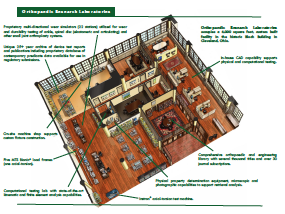Standards Testing

Standards Testing - Trauma
For more than four decades, ORL is recognized as an innovator of testing standards and methods with an extensive track record of providing information necessary for successful regulatory approvals, product quality confirmation, marketing materials and surgeon education. This Standards listing encapsulates the breadth of this expertise.
ASTM F382 - Standard Specification and Test Method for Metallic Bone Plates
This test method establishes a uniform four-point bending fatigue test to characterize and compare the fatigue performance of different bone plate designs. This test method may be used to determine a fatigue life of the bone plate at either a specific maximum bending moment or over a range of maximum bending moment conditions.
ASTM F543 - Standard Specification and Test Methods for Metallic Medical Bone Screws
This test method is used to measure the torsional yield strength, maximum torque, and breaking angle of the bone screw under standard conditions.
ASTM F564 - Standard Specification and Test Methods for Metallic Bone Staples
This test method is used to determine the fatigue resistance of metallic bone staples when subjected to repetitive loading for large numbers of cycles.
ASTM F1264 - Standard Specification and Test Methods for Intramedullary Fixation Devices
This test method describes a static bending test to determine the bending stiffness and bending strength of the central and uniform portions of an intramedullary fixation device.
ASTM F1541 - Standard Specification and Test Methods for External Skeletal Fixation Devices
This specification provides a characterization of the design and mechanical function of external skeletal fixation devices, test methods for characterization of mechanical properties, and identifies needs for further development of test methods and performance criteria.
ASTM F2502 - Standard Specification and Test Methods for Absorbable Plates and Screws for Internal Fixation Implants
This specification establishes standard test methods to consistently measure performance-related mechanical characteristics of absorbable devices when tested under defined conditions of pretreatment, temperature, humidity, and testing machine speed.
ASTM F384 - Standard Specifications and Test Methods for Metallic Angled Orthopedic Fracture Fixation Devices
The test method establishes a uniform cantilever bending fatigue test to characterize and compare the fatigue performance of different angled device designs. This test method may be used to determine the fatigue life of an angled device at either a specific or over a range of maximum bending moment conditions.
ISO 15142-1 - Implants for surgery — Metal intramedullary nailing systems — Part 1: Intramedullary nails
Specifies metallic medical devices used for the temporary intramedullary stabilization of long bones by surgical implantation, defining terms and giving requirements for intramedullary nails.
ISO 15142-2 - Implants for surgery — Metal intramedullary nailing systems — Part 2: Locking components
Specifies metallic medical devices used for the temporary intramedullary stabilization of long bones by surgical implantation, classifying and giving requirements for the locking components of intramedullary nails.

